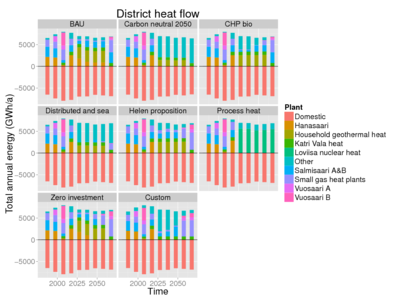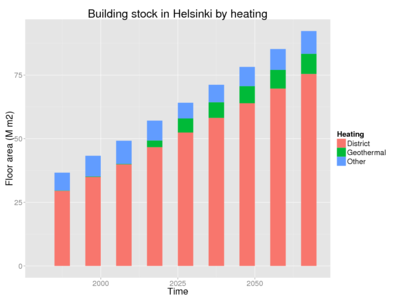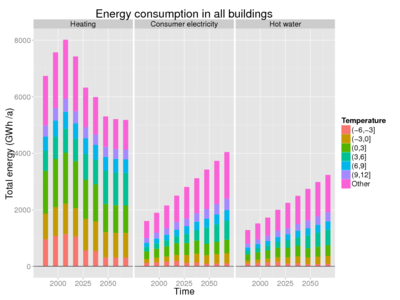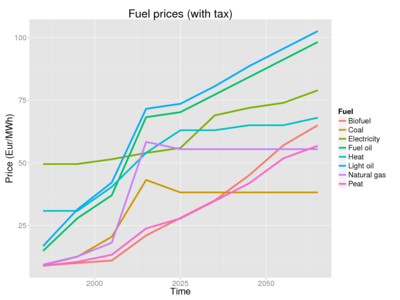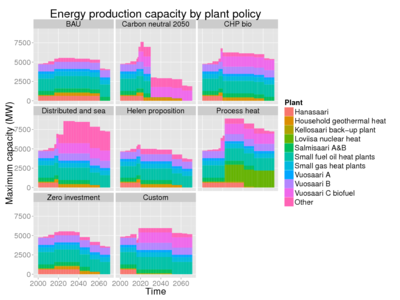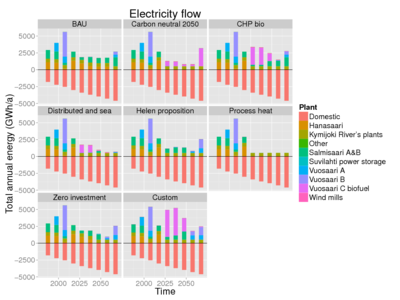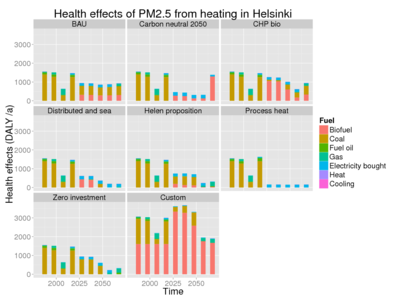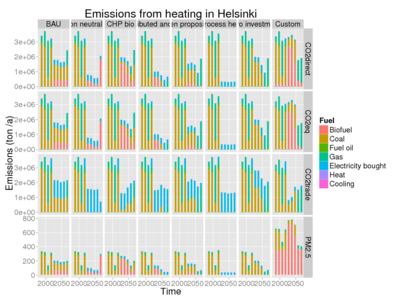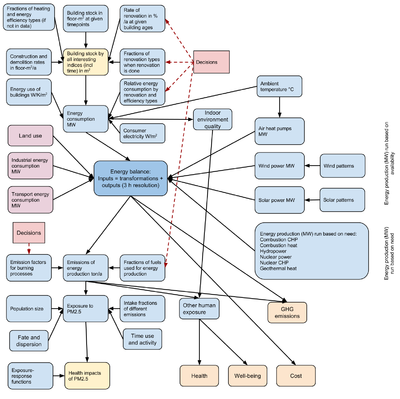Helsinki energy decision 2015
| Main message: |
|---|
| Question:
Helsinki will make a large energy decision during fall 2015. it will impact energy production for decades. An important decision requires systematic information. How do we guarantee a continuous and sufficient supply of district heat and electricity in Helsinki around the year for the next fifty years in such a way that the impacts on costs, health, climate change, and sustainable growth are as beneficial as possible? How can decentralised energy production and energy efficiency renovations improve the situation? The latter question was asked by the City Council, and another assessment (coordinated by the city of Helsinki and Helen energy company) will answer that soon. National Institute for Health and Welfare (THL) performed an open assessment on the Opasnet web-workspace during summer and fall 2015 aiming at shared understanding. We utilised knowledge crystals, i.e. regurlarly updated collaborative online answers to specific research questions. Based on them, we built a model called Sofia to assess impacts and implementability of several different energy options in Helsinki. An assessment report| has been published in Finnish. Sofia can estimate the building stock and energy consumption based on average energy efficiency, floor area, and ambient temperature. Sofia is an energy balance model that optimises costs of energy production while ensuring the supply of district heating in Helsinki for each day. The situation is followed from 1985 to 2065. Sofia looks also at other heat, fuel, and electric power consumption, but not those of industry and traffic. Based on balanced energy production Sofia estimates the fuel and other costs and greenhouse gas and fine particle emissions from power plants and other energy processes. The model can assess several scenarios and thus compare the overall impacts of different actions, such as energy renovations or new power plants. Sofia's main conclusion is that the energy solutions seem to fall into two categories: those that produce electric power as a side stream of district heat, like in Hanasaari coal plant and the suggested Vuosaari C biofuel plant; and those that do not produce or even consume a large amount of electricity, like decentralised biofuel heat plants or sea heat pumps. Based on current discussions, the self-sufficiency of electric power in Helsinki seems to be disappearing and probably changing into a deep dependency of outside electricity. The development of the Nordic electric market determines whether this will be a problem or not in the future. Unfortunately, the electric market is under strong transition, and for example the wind power tariffes complicate the situation, making future predictions of this crucial issue even more difficult. Local heat production solutions are in a great need of a clear and systematic national electric policy. Otherwise, the previously very efficient combined heat and power production will be replaced with something much less efficient in Finland in the future. If we forget the question about self-sufficiency of electric power and focus only on district heat, there are several cost-effective solutions available. Excess heat from different processes such as data centres or Neste oil refinery seem to be more cost-effective than e.g. Vuosaari C biofuel plant. Also small and large heat pumps that take heat from the environment are cost-effective. District heat from Loviisa 3 nuclear power plant is also cost-effective in our estimates, but we were not able to fully charaterise uncertainties in the investment cost; and we must remember that the decision to build or not to build the reactor is not in the hands of Helsinki. A major problem with the process heat solutions is that they consume electric power exactly when the demand for power is the largest and price the highest. We were not able to assess the variability of the price of electricity in this assessment, but it is substantial and might change conclusions. Also for this reason, there is a need for a national energy balance model with hourly resolution including eletricity, industry, and traffic. Health and climate impacts are important in every single option we looked at, together ranging between a fifth and a fourth of all costs, health and climate comprising a half of that each. Surprisingly, differences between policy options in this respect were small even if the reputation of the climate-friendliness of the options was very different. According to Sofia, this is due to several reasons. All large power plants filter fine particles out very effectively, and therefore there are no large differences in health impacts; a clear exception is small-scale wood burning in houses, which has several times larger health problems than any other option despite its marginal role in energy production. Also, the life cycle emissions of fine particles and greenhouse gases is also important: even if the direct emissions from a heat pump are zero, the electric power imported has produced emissions somewhere. Biofuels are considered climate neutral in emission trade, but they still produce emissions during their life cycle. Therefore, even a fuel switch does not produce the expected results. Of course, the conclusions based on the model depend on the goodness of the data used. There are several uncertainties that should have been clarified had there been more time to work on the topic. Especially the fuel prices are very difficult to predict into the future. Also the fuel taxes are very high for some fuels but not for others. Effectively, the society decides, using taxes, which solutions make sense on the city level. This is a third reason why there should be a national, long-term, and clear energy policy - and tax policy supporting it - based on detailed, open energy balance modelling the best available information. |
Scope
Question
Helsinki must be able to provide its residents with reliable, climate-friendly and cost-effective district heating and electricity every day all year round for the decades to come. When this energy balance is assessed, what options does Helsinki have for main energy solutions? What kind of impacts do these options have in terms of
- climate mitigation,
- stability (fuel availability etc),
- cost to the city and citizens,
- environment,
- biofuel use,
- national energy balance,
- domestic source,
- health?[1]
Intended use and users
Helsinki City Council will make a major decision in autumn 2015 about renovating old power plants, building a new one, or some other option replacing the need of the old power plants. Therefore, the City Council is the major user of the assessment. There are also secondary uses, such as informing national energy discussion and demonstrating the usefulness of an open combined energy balance and building model.
Participants
The work is coordinated by Jouni Tuomisto from THL / Impact Assessment Unit. Their motivation is to contribute to the decision-making process by bringing quantitative results to help assess the health and other impacts of different options in a transparent manner. Participants that we hope get involved when they are informed about the assessment include
- THL: Jouni, Pauli, Teemu, Matleena, Julia
- the City of Helsinki,
- Helen energy company
- Uusi energiapolitiikka group
- Energiaremontti 2015
Boundaries
- Time: 1985 - 2065
- Energy need estimated for Helsinki.
- Main focus is on local heat and power need. Energy balance estimated for Helsinki (electricity nationally).
- Health impacts estimated for the regional area (ca. 300 km radius)
- Impacts are assessed separately for the citizen, the city, Helen energy company, and Finland.
- Transport is not looked at although it is an important energy consumer. This is because there is no interaction with heating except via city structure, and there are no resources to look at that in this assessment. Electric cars would have an interaction with electricity production, but that applies to the total electricity market area (Finland, partly Scandinavia) and is too complex to look at.
Decisions and scenarios
- Main article: Helsinki energy decision options 2015
The two options in the official decision preparation as of May 2015 are i) Hanasaari shutdown and Vuosaari C, and ii) Hanasaari 40 bio and Salmisaari 40 bio. However, also other options have been suggested, and also they are evaluated at least superficially.
- BAU: Only small, essential renovations are made to current power plants to stay within new emission limits.
- Vuosaari C: A new power plant is built in Vuosaari with the capacity to burn 100 % wood-based fuel or any combination of wood-based fuels and coal.
- Hanasaari shutdown: The Hanasaari powerplant is shut down, demolished and apartment buildings are built in its place.
- Hanasaari 40 bio: The Hanasaari power plant is renovated to burn 40% wood-based fuels and 60% coal.
- Salmisaari 40 bio: The Salmisaari power plants are renovated to burn 40% wood-based fuels and 60% coal.
- Biofueled heat production units: Salmisaari oilfueled heat plant is shut down and new biofuel burning heat plants are built in Salmisaari and Vuorsaari.
- Loviisa nuclear CHP: A third nuclear power plant is built in Loviisa and the heat is used for district heating in Helsinki.
- Neste excess heat: The excess heat from the Neste's oil refinery in Porvoo is used for district heating in Helsinki.
- Decentralised energy production: The amount of decentralised energy production is increased as much as possible. Practically this means building a lot more solar panels, geothermal power, small-scale wood burning and wind mills around Helsinki.
- Large heat pumps: Big heat pumps are installed to draw heat from the Baltic sea or deep from the ground to produce district heating.
- Energy saving: With huge energy saving campaigns and by renovating buildings to be more energy efficient the amount of required energy is decreased significantly.
| BAU | Process heat | Helen proposition | Zero investment | Carbon neutral 2050 | CHP bio | Distributed and sea | |
|---|---|---|---|---|---|---|---|
| Biofuel heat plants | No | No | Yes | No | Yes | No | No |
| CHP diesel generators | No | No | No | No | No | No | Yes |
| Data center heat | No | Yes | No | No | No | No | Yes |
| Deep-drill heat | No | No | No | No | No | No | Yes |
| Hanasaari | renovated for biofuels | Yes | No | Yes | No | No | No |
| Household air heat pumps | Yes | No | Yes | Yes | Yes | Yes | Yes |
| Household air conditioning | Yes | No | Yes | Yes | Yes | Yes | Yes |
| Household geothermal heat | Yes | No | Yes | Yes | Yes | Yes | Yes |
| Household solar | Yes | No | Yes | Yes | Yes | Yes | Yes |
| Katri Vala cooling | Yes | Yes | Yes | Yes | Yes | Yes | Yes |
| Katri Vala heat | Yes | Yes | Yes | Yes | Yes | Yes | Yes |
| Kellosaari back-up plant | Yes | Yes | Yes | Yes | Yes | Yes | Yes |
| Kymijoki River's plants | Yes | Yes | Yes | Yes | Yes | Yes | Yes |
| Loviisa nuclear heat | No | Yes | No | No | No | No | No |
| Neste oil refinery heat | No | Yes | No | No | Yes | No | No |
| Salmisaari A&B | renovated for biofuels | Yes | Yes | Yes | No | renovated for biofuels | Yes |
| Sea heat pump | No | No | No | No | Yes | No | Yes |
| Sea heat pump for cooling | No | No | No | No | No | No | Yes |
| Small-scale wood burning | No | No | No | No | No | No | No |
| Small gas heat plants | Yes | Yes | Yes | Yes | No | Yes | Yes |
| Small fuel oil heat plants | Yes | Yes | Yes | Yes | No | Yes | Yes |
| Suvilahti power storage | Yes | Yes | Yes | Yes | Yes | Yes | Yes |
| Vanhakaupunki museum | Yes | Yes | Yes | Yes | Yes | Yes | Yes |
| Vuosaari A | Yes | Yes | Yes | Yes | No | Yes | Yes |
| Vuosaari B | Yes | Yes | Yes | Yes | No | Yes | Yes |
| Vuosaari C biofuel | No | No | No | No | Yes | Yes | No |
| Wind mills | No | No | No | No | Yes | Yes | Yes |
| Show details | ||||||||||||||||||||||||||||||||||||||||||||||||||||||||||||||||||||||||||||||||||||||||||||||||||||||||||||||||||||||||||||||||||||||||||||||||||||||||||||||||||||||||||||||||||||||||||||||||||||||||||||||||||||||||||||||||||||||||||||||||||||||||||||||||||||||||||||||||||||||||||||||||||||||||||||||||||||||||||||||||||||||||||||||||||||||||||||||||||||||||||||||||||||||||||||||||||||||||||||||||||||||||||||||||||||||||||||||||||||||||||||||||||||||||||||||||||||||||||||||||||||||||||||||||||||||||||||||||||||||||
|---|---|---|---|---|---|---|---|---|---|---|---|---|---|---|---|---|---|---|---|---|---|---|---|---|---|---|---|---|---|---|---|---|---|---|---|---|---|---|---|---|---|---|---|---|---|---|---|---|---|---|---|---|---|---|---|---|---|---|---|---|---|---|---|---|---|---|---|---|---|---|---|---|---|---|---|---|---|---|---|---|---|---|---|---|---|---|---|---|---|---|---|---|---|---|---|---|---|---|---|---|---|---|---|---|---|---|---|---|---|---|---|---|---|---|---|---|---|---|---|---|---|---|---|---|---|---|---|---|---|---|---|---|---|---|---|---|---|---|---|---|---|---|---|---|---|---|---|---|---|---|---|---|---|---|---|---|---|---|---|---|---|---|---|---|---|---|---|---|---|---|---|---|---|---|---|---|---|---|---|---|---|---|---|---|---|---|---|---|---|---|---|---|---|---|---|---|---|---|---|---|---|---|---|---|---|---|---|---|---|---|---|---|---|---|---|---|---|---|---|---|---|---|---|---|---|---|---|---|---|---|---|---|---|---|---|---|---|---|---|---|---|---|---|---|---|---|---|---|---|---|---|---|---|---|---|---|---|---|---|---|---|---|---|---|---|---|---|---|---|---|---|---|---|---|---|---|---|---|---|---|---|---|---|---|---|---|---|---|---|---|---|---|---|---|---|---|---|---|---|---|---|---|---|---|---|---|---|---|---|---|---|---|---|---|---|---|---|---|---|---|---|---|---|---|---|---|---|---|---|---|---|---|---|---|---|---|---|---|---|---|---|---|---|---|---|---|---|---|---|---|---|---|---|---|---|---|---|---|---|---|---|---|---|---|---|---|---|---|---|---|---|---|---|---|---|---|---|---|---|---|---|---|---|---|---|---|---|---|---|---|---|---|---|---|---|---|---|---|---|---|---|---|---|---|---|---|---|---|---|---|---|---|---|---|---|---|---|---|---|---|---|---|---|---|---|---|---|---|---|---|---|---|---|---|---|---|---|---|---|---|---|---|---|---|---|---|---|---|---|---|---|---|---|---|---|---|---|---|---|---|---|---|---|---|---|---|---|---|---|---|---|---|---|---|---|---|---|---|---|---|---|---|---|---|---|---|---|---|---|---|---|---|---|---|---|---|---|---|---|---|---|---|---|---|---|---|---|---|---|---|---|---|---|---|---|---|---|---|---|---|
|
There are two policies that are currently implemented in the model. Each has several options:
- Energy saving policy: take several actions that reduce the energy demand of the building stock.
- BAU: business as usual, e.g. renovate 1 % of buildings per year if age > 30 a.
- Energy saving moderate: renovate 2 %/a
- Energy saving total: renovate 4 %/a, in addition increase the share of passive buildings up by 25 %-units since 2025, and add the share of sheath reform renovations up by 25 %-units.
- WWF energy saving: energy saving according to WWF energy saving plan published 8th October 2015. It is based on efficient energy saving actions on buildings and consequental possibility to reduce coal energy. The savings are based on increased energy renovations (2.5 % per year), more effective renovations in 10 % of renovation cases, and demolition of old buildings (1 % per year).[2]
- Plant policy: Choose an optimal selection of power plant infrastructure. These poicy options are the main focus of the assessment. There is a separate table describing these options.
Timing
The assessment started in May 2015. First draft results are expected before midsummer 2015. Final results should be available well before the City Council makes the decision in autumn, which means that results should exist by September 15th, 2015. There will be a public meeting to present the near-final results and discuss their implications. The meeting was held in THL, Helsinki on 11st September 2015 at noon. The final report was published on 27th October 2015.
Answer
Model with user interface
The final results results can be found from model run 1.11.2015 (token 144638929414). It is the final archived version in English. Objects were stored, so you can download the whole assessment to R in your own computer.
- Model run 26.10.2015 graphs in Finnish 20.11.2015 additional graphs
- Intermediate results are available at section #See also.
Results
Conclusions
See summary in the beginning.
Rationale
Stakeholders
The impacts are assessed and valued from the point of view of the following stakeholders:
- The city of Helsinki
- Helen Oy energy company
- A citizen of Helsinki
- Finland
- Global view
Dependencies
- List of key pages used in model
- Helsinki energy decision 2015: Main page of assessment.
- Helsinki energy decision options 2015: More detailed information on the different options available.
- Building model: Method of estimating the size of the building stock of a city, including heating properties and renovations.
- Building stock in Helsinki: Data on the building stock in Helsinki and its projected future.
- Energy use of buildings: Method of estimating energy need based on building stock and outdoor temperature.
- Helsinki energy consumption: Data on the energy consumption of buildings.
- Energy balance: Method of calculating energy balance.
- Helsinki energy production: Data on the energy production in Helsinki.
- Energy balance in Helsinki: Data on the amounts of energy produced, consumed, imported, and exported in Helsinki.
- Emission factors for burning processes: Data on the emission factors for burning processes in Finland.
- Prices of fuels in heat production: Data on market prices of fuels used in Helsinki
- Other models used in the Helsinki assessment (but are not in the core of this assessment)
- Burden of disease in Finland: Data on disease burden.
- Exposure-response function: Description of ERF, a mathematical construct used to describe a probability of different responses to a given exposure.
- Health impact assessment: Method of estimating the health impacts of a particular event or policy.
- ERFs of environmental pollutants: Data on the exposure-response function of several environmental pollutants that do not have their own pages.
- Exposures in Finland: Data on the typical exposure levels of common pollutants in Finland.
- Disease risk: Data on the incidence or prevalence rates of different diseases in Finland.
- Population attributable fraction: Method of calculating the fraction of disease that would disappear if the exposure to that agent would disappear.
- Population of Helsinki metropolitan area: Data on the total population of Helsinki metropolitan area.
- Intake fractions of PM: Data on the intake fractions of airborne particulate matter for different emission sources and locations.
- Exposure to PM2.5 in Finland: Method of estimating exposure to fine particles (PM2.5) in the Finnish population.
- Emission assessment of small-scale energy production in the Helsinki metropolitan area: Assessment evaluating the greenhouse gas emissions and emission trading costs of small-scale (output less than 50 MW) energy production in the Helsinki metropolitan area.
- OpasnetUtils/Drafts
| Variable | Measure | Indices |
|---|---|---|
| buildings (from the Building model) | ||
| stockBuildings From statistics data in OB | Building stock in floor-m2 at given timepoints: Stock details in Opasnet Base | Time (Valmistusmisaika), City_area (Sijainti), Building (Käyttötarkoitus), Heating (Lämmitystapa, Polttoaine), Efficiency (Varusteena koneellinen ilmanvaihto, Perusparannus) |
| heatingShares = 1 Building stock in Helsinki | Fractions of heating types. Should sum up to 1 within each group defined by optional indices. Data is already in stockBuildings, so we use 1 here. | Heating, Time, Building |
| efficiencyShares Energy efficiency of new buildings in the future. OpasnetBase | Fraction of energy efficiency types of new buildings in the future. Should sum up to 1 for each group defined by other indices. Fractions of heating and energy efficiency: from Facta data and Energiatodistusrekisteri This can be used to derive energy classes and the U values for buildings in Helsinki. | Efficiency, Time, Building. |
| changeBuildings = stockBuildings * 0.02 /a | Construction or demolition rate as floor-m2 at given timepoints. Implemented in code. | Time, Efficiency, Heating. changeBuildings should have all indices in stockBuildings, heatingShares, and efficiencyShares. |
| renovationShares Guesstimate data in OB | Fraction of renovation types when renovation is done. Should sum to 1 for each group defined by other indices. | Renovation, Startyear. Startyear is the time when the renovation is done, and it must be different than the Time index. |
| renovationRate Guesstimate data in OB | Rate of renovation (fraction per time unit). | Age (the time difference between construction and renovation, i.e. Startyear - Time for each building). |
| obstime Ten-year intervals 1980 - 2060. | one-column data.frame about the years to be used in output. | Startyear |
| heating_before = FALSE | If TRUE, heatingShares contains data and is added to buildings before obstime. | |
| efficiency_before = TRUE | If TRUE, efficiencyShares contains data and is added to buildings before obstime. | |
| heatingEnergy: Energy consumption from the Building model ←--#: . Move code to Heating consumption of buildings --Jouni (talk) 03:48, 9 June 2015 (UTC) (type: truth; paradigms: science: defence) | ||
| energyUse Baseline energy consumption [3] ←--#: . Update this to use U values and ambient temperatures. --Jouni (talk) 12:22, 24 May 2015 (UTC) (type: truth; paradigms: science: defence) Also use Building stock in Helsinki, Table 6. | Energy consumption per floor area (kWh / m2 /a) (U: W/m2/K * T: K * Area: m2) | Building, Heating. |
| efficiencyRatio Energy use of buildings#Energy efficiency in heating) Opasnet Base | Relative energy consumption compared with the efficiency group Old. | Efficiency. |
| renovationRatio Impact of renovations Opasnet Base | Relative energy consumption compared with the Renovation location None. | Renovation. |
| energyBalance Energy balance in Helsinki | ||
| heatingEnergy (see above) | ||
| consumerElectricity: from Baseline energy consumption Opasnet Base based on floor area | Amount of consumer electricity use (MW) calculated based on either amount of people or floor-m2 | Hour (time of day), others? |
| otherEnergy Helsinki energy consumption | Other energy consumption (industry, transport, other): from statistics of Helsinki Helsingin ympäristötilasto. Thermal energy need in Helsinki Metropolitan Area | Time |
| windElectricity Check [1] about possibilities and Wind pattern Tuuliatlas about useful wind mill sites in Helsinki. | Amount of wind power produced (MW) by wind type. We also need amounts of hours with different wind patterns per year. | Hour (do we need this, is wind power production dependent on time of day?), Weather (temperature and weather types), maybe Wind (Windy, Normal, Calm) |
| solarElectricity | Amount of solar energy produced (MW) in certain conditions. Data source? | Hour, Month, Weather, maybe Sun (Sunny, Cloudy, Dark) ----#: . Have to decide which of these is used. --Jouni (talk) 17:27, 24 May 2015 (UTC) (type: truth; paradigms: science: comment) |
| airpumpHeat | This means air-driven heat pumps installed in individual homes and run based on ambient temperature. The efficiency of air heat pump reduces with very cold weather. We assume that the heat pump will be used for cooling as well, if it is installed. (We assume that cooling is not used in apartments without heat pump; cooling is otherwise only used in offices etc). | Weather, Hour, maybe Temperature. ----#: . Should we have index for day/night so that daily storage of heat/cool can be assessed? --Jouni (talk) 17:27, 24 May 2015 (UTC) (type: truth; paradigms: science: comment) |
| energyProduction Helsinki energy production | Energy production based on need: basically, we need to know a) what power plants exist, b) what fuels they use and what (heat, power or both) they produce, c) what emissions they produce, d) what is their maximum capacity, e) at what demand level are they turned on.
|
|
| emissions (from the model) (emissions in mass per time) Emissions of energy production (ton/a). Emission assessment of small-scale energy production in the Helsinki metropolitan area | ||
| energyBalance (from the model; see above) | ||
| fuelShares Energy balance in Helsinki[3] | Tells how much of fuel is used for a certain neating energy need. ----#: . Should this be on page Energy balance in Helsinki or, like in Kuopio and Basel, a separate table? --Jouni (talk) 17:27, 24 May 2015 (UTC) (type: truth; paradigms: science: comment)
----#: . Use shares of different fuels. Currently this data is on page Emission factors for burning processes Table Fuel use in different heating types. However, this is clearly case-specific data and should be on a case-specific page. This should be done retrospectively to Kuopio and Basel as well. --Jouni (talk) 12:22, 24 May 2015 (UTC) (type: truth; paradigms: science: comment) |
Fuel_type. |
| emissionFactors Emission factors for burning processes | emissions per unit of energy produced (g / J or similar unit) [4] | Exposure_agent, Emission_height. |
| exposure is in ug/m3 in ambient air average concentration. Exposure to PM2.5 in Finland | ||
| emissions | (from the model; see above) is in ton /a | Time, City_area, Exposure_agent, Emission_height. |
| iF (generic data but depends on population density, emission height etc) Intake fractions of PM. | conc (g /m3) * pop (#) * BR (m3 /s) / emis (g /s) <=> conc = emis * iF / BR / pop # conc is the exposure
⇤--#: . This is NOT the right page, but there are some pages such as Exposure to PM2.5 in Finland that should be merged. --Jouni (talk) 15:45, 17 May 2015 (UTC) (type: truth; paradigms: science: attack) ⇤--#: . Rather use iFs based on Piltti? --Jouni (talk) 12:22, 24 May 2015 (UTC) (type: truth; paradigms: science: attack)
|
Emission_height, Pollutant, Area |
| population Population of Helsinki metropolitan area | Amount of population exposed. Data from Statistics Finland? | Time, Area, Age, Sex |
| ambientTemperature: Weather in Helsinki (also contains solar radiation and wind patterns) | Ambient temperatures. ----#: . We actually need hourly temperatures. How do we manage this in the model? Temperatures should match indices Sun, Wind, Hour, and Month. --Jouni (talk) 17:27, 24 May 2015 (UTC) (type: truth; paradigms: science: comment) | |
| Health impact assessment | ||
| exposure (see above) | ||
| Disease risk | Incidences of diseases of interest. ----#: . What if prevalence values would be more useful? --Jouni (talk) 17:27, 24 May 2015 (UTC) (type: truth; paradigms: science: comment) | Age, Sex, Response |
| ERF Exposure-response function | Exposure-response functions of all relevant exposure agents | |
| Burden of disease in Finland | ||
| Other human health effects, indoor environment, and well-being is not probably handled here? Remove or keep as an important placeholder? | ||
| Costs: Where do we get this? From Vuosaari YVA? From [1]? | Costs of activities (energy production mainly) but also health impacts. | Time |
Analyses
- Cost-benefit analysis of different options. Costs considered: capital and operational costs of energy production, climate costs (CO2e emissions converted to euros), health (DALYs converted to euros).
- Total capacity availability and feasibility (applies especially to decentralised option).
- Temporal heat and power demand and supply (hourly resolution).
Indices
- Temporal: Time (5-year observation periods)
- Temperature (3-degree-Celsius intervals for ambient daily average temperatures. It is assumed that heating is not needed above 17 C and cooling is not needed below 24 C. Hot water need is independent of ambient temperature.
- Decisions: EnergySavingPolicy contains options that reduce the energy need of the building stock and other consumption. PlantPolicy contains options about which energy plants to build (or demolish).
- Stakeholder (Citizen, City, Helen, Finland)
- Spatial: City area (summed up after energy need)
- Health: Response (any disease that is linked to Exposure agents emitted)
- Emission, exposure: Pollutant or Exposure agent (any agent that is emitted by energy production)
- Energy production: Burner (type of burner used in the facility where energy is produced), Fuel (type of fuel used in energy production), Heating (type of heating in the building).
- Buildings: Building [use type], Heating, Constructed, City area, Renovation, Efficiency.
Case-specific ovariables
Name is the name of ovariable that has case-specific rather than default content. Ident is the indentifier of the code that defines the case-specific ovariable. Token is the same as Ident but it uses a specific version of the code rather than the newest version. Latest is the code for an ovariable whose dependencies will be changed, i.e. who has the case-specific ovariable as parent. Get is the same as Latest but a specific version rather than the newest version is fetched.
| Obs | Name | Ident | Token | Latest | Get | Description |
|---|---|---|---|---|---|---|
| 1 | buildings | Op_en6289/buildingstest | Op_en5488/EnergyConsumerDemand | [[Building model]] buildings # Generic building model | ||
| 2 | changeBuildings | Op_en7115/changeBuildings | Op_en6289/buildingstest | |||
| 3 | demolitionRate | Op_en7115/demolitionRate | Op_en6289/buildingstest | |||
| 4 | efficiencyShares | Op_en5488/efficiencyShares | Op_en6289/buildingstest | |||
| 5 | emissionLocations | Op_en7311/emissionLocationsPerPlant | Op_en2791/emissionstest | [[Helsinki energy production]] emissionLocations, used by[[Emission factors for burning processes]] emissions | ||
| 6 | energyProcess | Op_en7311/energyProcess | Op_en5141/EnergyNetworkOptim | [[Helsinki energy production]] energyProcess, used by [[Energy balance]] EnergyConsumerDemandTotal | ||
| 7 | exposure | Op_en5813/exposure | [[Intake fractions of PM]] exposure # uses Humbert iF as default. | |||
| 8 | fuelShares | Op_en7311/fuelShares | Op_en2791/emissionFactors | [[Helsinki energy production]] fuelShares, used by ([[Emission factors for burning processes]] emissionFactors?) | ||
| 9 | plantParameters | Op_en7311/plantParameters | Op_en3283/totalCost | [[Helsinki energy production]] plantParameters, used by [[Economic impacts]] plantCost | ||
| 10 | renovationRate | Op_en7115/renovationRate | Op_en6289/buildingstest | [[Building stock in Helsinki]] renovationRate | ||
| 11 | Op_en7115/renovationRate | [[Building stock in Helsinki]] renovationRate case-specific adjustment in formula | ||||
| 12 | renovationShares | Op_en7115/renovationShares | Op_en6289/buildingstest | |||
| 13 | stockBuildings | Op_en7115/stockBuildings | Op_en6289/buildingstest | |||
| 14 | temperatures | Op_en2959/temperatures | Op_en5488/EnergyConsumerDemand | [[Outdoor air temperature in Finland]], used by [[Energy use of buildings]] EnergyConsumerDemand | ||
| 15 | temperdays | Op_en2959/temperatures | Op_en5488/EnergyConsumerDemand | [[Outdoor air temperature in Finland]] |
Calculations
- Model run 25.10.2015. Archived version with several updates
- Model run 17.12.2018 for HNH2035 [4]
Preference order
This code should be used for new model runs. It is newer but not fully adjusted for its purpose yet.
- Model run 22.10.2015 with updated fuel prices. This is NOT used for the assessment report, because the scenarios were based on the previous fuel prices.
This code was used for prioritizing before fuel prices were updated.
DALY shortcut
This code creates a ready-made DALYs estimate for 1 ug/m^3 PM2.5. It is much quicker to calculate health impacts of case-specific emissions with this ovariable, if there is a large emissions ovariable and if the exposure is such that proportionality can be assumed in health impacts.
See also
| Moderator:Jouni (see all) |
|
|
| Upload data
|
| Previous model runs and links |
|---|
Previous model runsFinal model
Intermediate calculations without plant optimising
Preference order calculations
Relevant links
toimenpiteet Helsingin kaupungin ympäristökeskuksen julkaisuja 7/2014 [14]←--#: . Kustannus- ja päästövähenemätiedot pitäisi tästä kerätä taulukkoon. --Jouni (talk) 13:29, 19 June 2015 (UTC) (type: truth; paradigms: science: defence)
|
Keywords
Energy, renewable energy, nuclear energy, fossil energy, wood pellets, power plants, district heating, decentralised energy production, centralised energy production, cost-effectiveness, Helsinki, climate change, health effects, fine particles, biofuels, energy saving.
References
- ↑ 1.0 1.1 1.2 Halme, Minna; Hukkinen, Janne; Korppi-Tommola, Jouko; Linnanen, Lassi; Liski, Matti; Lovio, Raimo; Lund, Peter; Luukkanen, Jyrki; Nokso-Koivisto, Oskari; Partanen, Jarmo; Wilenius, Markku. Kasvua ja työllisyyttä uudella energiapolitiikalla. Jyväskylän yliopiston julkaisuja 2014. [1]
- ↑ WWF. Helsingin energiapäätös. Energiansäästö on polttoainevaihtoehdoista paras. WWF, 8.10.2015 http://wwf.fi/mediabank/7784.pdf [2]
- ↑ Jáchym Judl, Sirkka Koskela, Timo Korpela, Niko Karvosenoja, Anna Häyrinen, Jari Rantsi. Net environmental impacts of low-share wood pellet co-combustion in an existing coal-fired CHP (combined heat and power) production in Helsinki, Finland. Energy 77 (2014) 844-851. doi:10.1016/j.energy.2014.09.068
- ↑ Sanni Väisänen: Greenhouse gas emissions from peat and biomass-derived fuels, electricity and heat — Estimation of various production chains by using LCA methodology
Related files
-
 Assessment of small-scale energy production in Helsinki Metropolitan area ←--#: . This contains all Pasi's assessment's data tables and is very useful! --Jouni (talk) 17:05, 14 May 2015 (UTC) (type: truth; paradigms: science: defence)
Assessment of small-scale energy production in Helsinki Metropolitan area ←--#: . This contains all Pasi's assessment's data tables and is very useful! --Jouni (talk) 17:05, 14 May 2015 (UTC) (type: truth; paradigms: science: defence)

